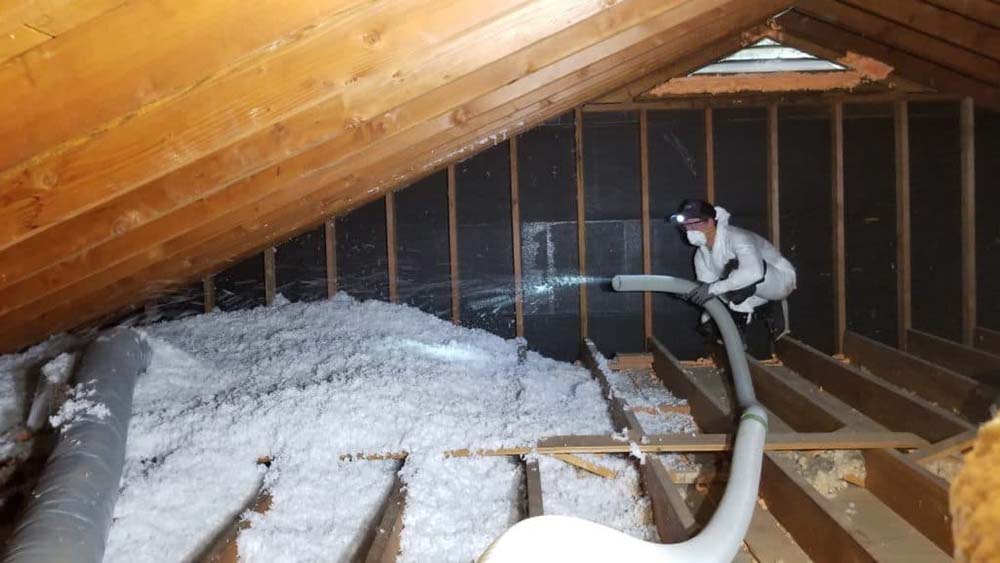Menu
fiberglass Blown-In Insulation, the most popular type, is formed of plastic filaments that have had recycled glass spun into strands. The fibers are then pulled, causing them to become tiny.

Fiberglass blown-in insulation in Toronto is a popular type of insulation material used to improve energy efficiency and comfort in homes. It consists of small glass fibers that are blown into attics, walls, or other areas using specialized equipment.
Fiberglass insulation is non-combustible, mold-resistant, and helps reduce noise transmission. It is eco-friendly, made from recycled materials, and has a long lifespan.
In Toronto’s climate, fiberglass blown-in insulation is particularly beneficial to combat temperature extremes and reduce heating and cooling costs. Its easy installation process makes it a cost-effective solution for homeowners looking to improve insulation in their properties.
Fiberglass blown-in insulation offers several benefits that can improve your home’s energy efficiency and comfort.
Energy Savings: Fiberglass blown-in insulation helps to reduce heat transfer, keeping your home warmer in the winter and cooler in the summer. This can lead to significant energy savings and lower utility bills.
Comfort Enhancement: By filling gaps and voids, fiberglass blown-in insulation creates a more even temperature throughout your home. Say goodbye to drafts and cold spots, and enjoy a more comfortable living environment.
Noise Reduction: The dense fibers of fiberglass insulation act as a barrier to sound transmission, reducing unwanted noise from outside or between rooms. Enjoy a quieter and more peaceful home.
Fire Resistance: Fiberglass insulation is non-combustible, making it a safe choice for your home. It can help slow down the spread of fire and provide valuable time for evacuation.
Mold and Moisture Protection: Fiberglass insulation is resistant to mold growth, preventing potential health issues and protecting your home from moisture-related damage.
Easy Installation: Fiberglass blown-in insulation can be quickly and easily installed using specialized equipment. It can be blown into hard-to-reach areas, ensuring comprehensive coverage.
Longevity: Fiberglass insulation is durable and does not settle over time, maintaining its effectiveness for years to come. Enjoy long-lasting insulation performance without the need for frequent replacements.
Lorem ipsum dolor sit amet, consectetur adipiscing elit. Ut elit tellus, luctus nec ullamcorper mattis, pulvinar dapibus leo.
Installing fiberglass blown-in insulation is a cost-effective way to improve the energy efficiency of your home and enhance comfort. This easy and straightforward process involves the injection of loose fiberglass fibers into your walls or attic spaces. Here’s a simple guide to help you understand the installation process.
Preparation: Before starting, ensure that your work area is clear of any obstructions. Wear protective clothing, gloves, and a mask to safeguard against fiberglass particles.
Assess the Area: Determine the areas where insulation is needed. Common locations include attics, wall cavities, and crawl spaces. Measure the square footage of these areas to determine the amount of insulation required.
Equipment: Gather the necessary equipment, including a blower machine, insulation material (fiberglass), a hose, and a helper (if needed).
Safety Precautions: Ensure proper ventilation in the work area. It’s important to cover any exposed skin and wear safety goggles to protect your eyes from fiberglass particles.
Preparing the Machine: Set up the blower machine according to the manufacturer’s instructions. Load the insulation material into the hopper, ensuring it is evenly distributed.
Blowing the Insulation: Position the hose at the starting point, usually the farthest corner of the area being insulated. Gradually feed the hose as the machine blows the insulation into the designated area, working methodically to cover the entire space evenly.
Filling Gaps and Gaps: Pay attention to hard-to-reach areas and ensure they are adequately filled with insulation. Use a rake or other tools to distribute the insulation evenly and reach tight spots.
Finishing Up: Once the desired thickness is achieved, switch off the blower machine. Check the insulation depth using a measuring stick to ensure it meets the recommended levels for energy efficiency.
Clean-up: Clean up any excess insulation material, dispose of any waste properly, and ensure the work area is left clean and tidy.
Installing fiberglass blown-in insulation is a straightforward process that can greatly improve your home’s energy efficiency and comfort. By following these simple steps and taking necessary safety precautions, you can successfully insulate your walls or attic with fiberglass blown-in insulation. Enjoy the benefits of a more energy-efficient and comfortable living space.

Toronto Spray Foam and Insulation has over 5 years of experience in providing spray foam insulation solutions for residential and commercial properties.
94 Kenhar Dr, North York, ON M9L 1N2 Unit 42